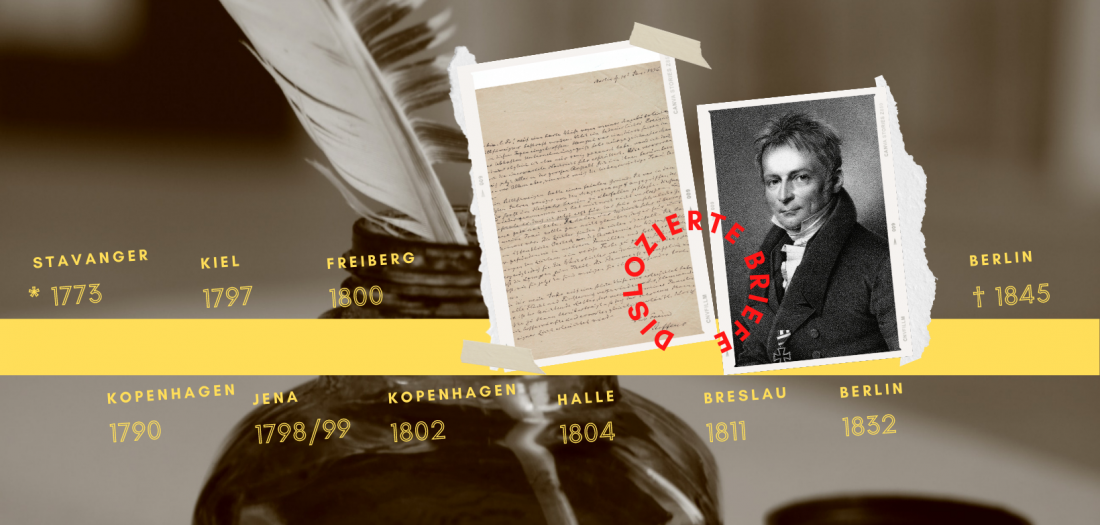Over 600 scattered letters from Henrik Steffens will be digitally networked
Together with the Humboldt-Universität zu Berlin, the TCDH starts the project of a digital collection on the estate of the natural philosopher Henrik Steffens (1773 - 1845)
04.02.2022 | Press Releases, Project News

Hintergrundbild by Joachim Schnürle on Unsplash, im Vordergrund Brief von „Henrik Steffens an Unbekannt, 14. Januar 1836“
Privatbesitz: Loose Blätter Sammlung sowie Henrich Steffens. Lithografie von Friedrich Jentzen nach einer Zeichnung von Franz Krüger.
“So all of Copenhagen turned out to hear this young savage.“”¹
The digital edition being created will include the correspondence of this natural philosopher, who is almost forgotten today. A Prussian scholar and university professor in Halle, Breslau, and Berlin, Steffens, who was born in Norway and educated in Denmark, is one of the central figures in German and European intellectual and university history, as well as one of the most important representatives of Scandinavian-German cultural relations in the 18th century.
In 1797 Steffens came to Jena and became part of the Jena Romantic Circle. Here he met and came to appreciate Friedrich Wilhelm Joseph Schelling, with whom he later shaped the speculative direction of natural philosophy. Together they became authoritative representatives of the principle of the unity of nature and spirit. He met the Schlegel brothers and became acquainted with Ludwig Tieck and Novalis (actually Georg Philipp Friedrich von Hardenberg), and later with Friedrich Schleiermacher and the composer Johann Friedrich Reichardt. In Freiberg, Steffens studied under the well-known geologist Abraham Gottlob Werner from 1799 to 1801. Dissatisfied in the Prussian province, he was appointed professor at the University of Berlin in 1832 by the favor of the Prussian crown prince, later King Frederick William IV.
His extensive scholarly work is significant not only for philosophy, but also for history, theology and literature; his essay “On the Idea of Universities” (1809) is one of the most important treatises on the modern university, along with the writings of Johann Gottlieb Fichte, Friedrich Schleiermacher and Wilhelm von Humboldt.
We collect and link letters and first person documents from over 40 European archives
With this new project, the TCDH was granted important funds to further expand its scientific expertise in the field of digital humanities, cultural studies and social sciences at the Trier site. It is also intended as a pilot project for a larger follow-up project and therefore initially focuses on the inventory and digital networking of the letters and first person documents in the possession of more than 40 European archives and libraries. It thus also creates the basis for further interdisciplinary research, above all by enabling efficient, thematically oriented source research that can be carried out on the web interface even without extensive knowledge of Henrik Steffens' life and work. In the spirit of Open Science, the resulting research data will be linked to central database systems such as the Gemeinsame Normdatei (GND) of the German National Library and will flow into the cross-project catalog for digitized correspondence (correspSearch) developed at the Berlin-Brandenburg Academy.
In view of the platforms of his contemporaries that have been created at the TCDH in recent years, the digital collection of Steffens' estate will form a further building block for the visualization of the wide-ranging letter network of that time. Here, the TCDH is building on its extensive experience from previous (letter) editions on representatives of the era, such as the Digitizing and Electronic Edition of August Wilhelm Schlegel's Correspondence, the Critical Friedrich Schlegel Edition, the digitization and electronic edition of the correspondence of Abraham Gottlob Werner, and the Johann Caspar Lavater Briefedition.
For the research data management for the digital collection, the tool "FuD", which was developed at the University of Trier and has proven itself in numerous comparable projects, is also used here. In order to be able to reuse the data in the long term, it is coded according to international standards (TEI/XML, METS/MODS). The scientific indexing of the correspondence of Henrik Steffens forms a new source basis for research in philosophy, social history, and literary studies by bringing together his estate for the first time and making it available in open access.
¹Henrich Steffens. Einleitung in philosophische Vorlesungen. Übersetzt und mit einer Vorbemerkung versehen von Heiko Uecker. 2012: XI.
Link: Henrik-Steffens-Portal

